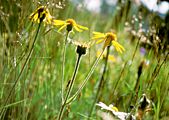Against all intuition, alpine plant tissues are not depleted in nutrients. In
fact, young pioneer communities in glacier forefields are particularly rich in
nutrients.
When samples of related species from low and high altitude are compared, the
alpine relative is commonly richer in nutrients.
1 -
Nitrogen concentrations (% dry matter) in leaves of comparable plant
species from low and high altitude in the northern Scandes (3.18 ± 0.51 %
versus 2.80 ± 0.58 %, n = 22/25, p = 0.02). The treeline in this area is at
650 m.
In late successional communities we often find species which are inherently low
in nutrients (e.g. some sedges), but this is also true for the low elevation
relatives of these species.

2 -
Old and stable nutrient depleted alpine sedge communities (Valais, Swiss
Alps).
2 -
Old and stable nutrient depleted alpine sedge communities (Valais, Swiss
Alps).

3 -
Old N-depleted pastures near the treeline (here of the Nardetum type
with
Arnica montana,
Asteraceae) can be very rich in species (W-Tyrol, Austrian Alps).
3 -
Old N-depleted pastures near the treeline (here of the Nardetum type
with
Arnica montana,
Asteraceae) can be very rich in species (W-Tyrol, Austrian Alps).
The shorter the growing season the higher the leaf nitrogen concentration per
unit dry matter.
4 -
The latitudinal variation of mean leaf nitrogen concentration in herbaceous
plant species close to the regional upper limits of higher plant distribution.
Numbers indicate the number of species sampled in each region. Note the inverse
relationship with length of season (shaded).




